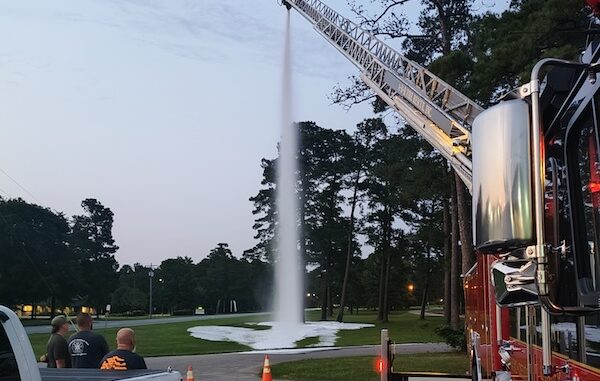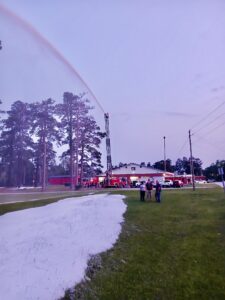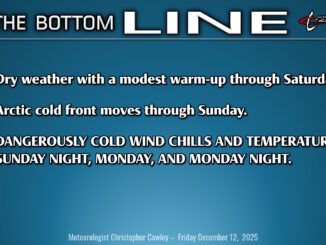
For years, Acme Delco Riegelwood Fire Rescue (ADR) has faced problems with flammable materials.
The thousands of commercial trucks move through the east end of Columbus every day. There’s also a concentration of industrial facilities that use a variety of chemicals and hazardous materials. ADR has used Class A and B foam fire suppression systems on three of its vehicles for years.
The department’s newest apparatus is upping its capabilities in using foam.
Wright Chemical recently donated a foam apparatus to ADR for fighting fires where water might not be enough or effective. The heart of the equipment is a trailer built by Combat Solutions of Fuquay Varina. The trailer was originally built in 2007 by Jim Cottrell, a retired Underwriters Laboratories (UL) tester who founded National Foam. The trailer was later installed on a motorized chassis to make it more deployable, ADR Chief Steve Camlin said.
“We’ve used this equipment around the county on several fires,” Camlin said.
The truck carries 560 gallons of Class B foam, and while it was designed for use at Wright Chemical, Camlin said it can easily be modified on a fire scene to suit the nature of the emergency. It can be deployed as a portable standalone unit or stationary.
Among the fires where firefighters used the system was a tanker crash in February 2022, when 8,000 gallons of gasoline and diesel caught fire.
Camlin said the new system is the top of the line current technology.
“Many foam gurus have come and gone,” he said. “Some from the old Zimmerman-Evans (systems) back in the 80s, Flint Josey from Charlotte and Chief Bobby Wilson of Guilford College Fire Department. These gentlemen saw fit to call us and ask how the foam did.” Camlin said the firefighters guided his firefighters through the entire process, to help crews find out more about the foam systems worked, from start to cleanup.

“All the learning back then was from the old protein foam that was used back pre-1970. That foam clogged up the inductors constantly and required cleaning, even while fire suppression was going on. We went from that to Fluroprotein, to Lightwater, then to various manufactured styles of Class B and similar foams.”
Wilson’s idea was to improve tactics as well as product, Camlin said.
“One of Chief Wilson’s goals was to have an elevated master stream to apply foam at a constant rate and flow from a ladder truck,” Camlin explained. “This made us think of our tanks at our oil and chemical properties.
“We had an aging nozzle on our ladder truck so we updated it to a newer model and added task force tips. We worked with Mr. Cottrell’s stepson Chris Carson to rework the nozzle to a different pressure to allow finished foam to come out at 75 feet in the air.”
On a recent regular training night, Camlin said, ADR firefighters got to test the updated equipment.
“We obtained some Class B foam form an area department,” he said. “It was set aside for disposal, but the Office of State Fire Marshall allowed us to use it to test our equipment. We decided to test our theory of foam application to a lot of the new members, who had never seen it done before.
“Through some introduction and hands-on demonstration, it performed as expected just like the pioneers of this process said it would.
Camlin said they started with an oscillating ground monitor, which would be used ina. real emergency to protect methanol tanks at Wright Chemical, then moved to an elevated position and ran the ladder out, dispensing the firefighting foam at different densities from above.
“Everyone was impressed,” Camlin said. Firefighters were also reviewed on various skills that go along with foam application, such as “blanketing”, runoff of used foam, and how to maintain the foam using gas monitors.
“All said and done it was some very successful training for our young new members and a good opportunity for everyone to absorb some knowledge from the. ‘old guys’.”
The foam system shows such promise that the department is buildings its own foam engine, Camlin said. ADR has purchased a used fire engine that has been renovated as a foam truck. To save money, Camlin said, much of the work is being down by firefighters.
The truck will carry 900 gallons of Class B foam, Camlin said.
“This is the latest technology and environmentally safe,” he explained. “The unit will have multiple lines, and also have twin 750 gallon per minute turrets to deploy foam. Simply add water to the pump, turn a couple levers and we have foam.”
The foam truck should be in operation. Next year, he said.
“All of this as a mission to achieve another way of overcoming a dangerous situation with little expense to the taxpayer,’ Camlin said. Most of our success came from dedication and never giving up.”
Camlin thanked Zimmer and Evans, the late Flint Josey, Cottrell and Dan Tyrell and Carson for their assistance.
“We greatly appreciate their participation in this educational experience,” Camlin said.






















